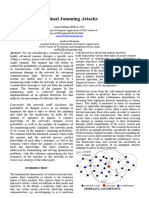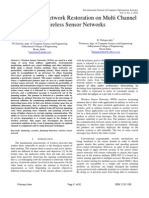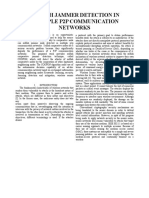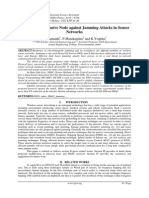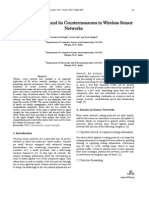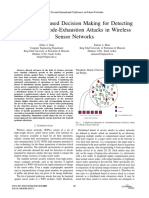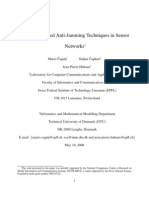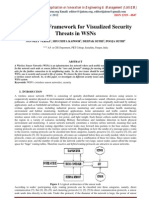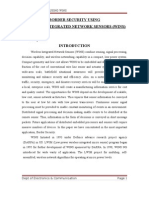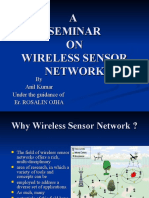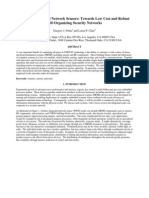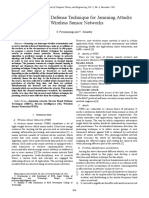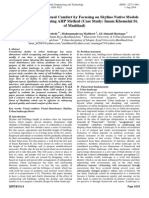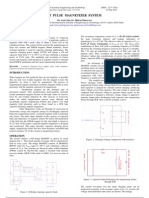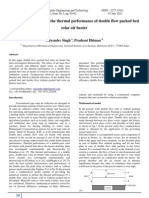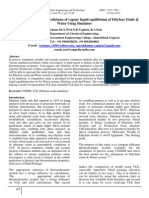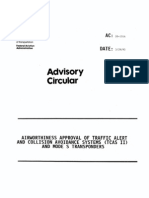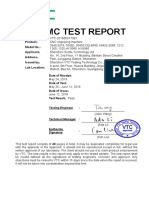0 ratings0% found this document useful (0 votes)
37 viewsIjset 2014 802
Ijset 2014 802
Uploaded by
Editorijset IjsetThis document summarizes a research paper that proposes a new approach to identify and neutralize reactive jammer nodes in wireless sensor networks. It discusses different types of jamming techniques that disrupt MIMO communication. The proposed system aims to identify trigger nodes that activate the jammers using group testing techniques. This enhances the identification speed and reduces the message complexity compared to traditional approaches. The system architecture and models for the network, attackers, and sensor nodes are described. Group testing is implemented to efficiently identify the trigger nodes.
Copyright:
© All Rights Reserved
Available Formats
Download as PDF, TXT or read online from Scribd
Ijset 2014 802
Ijset 2014 802
Uploaded by
Editorijset Ijset0 ratings0% found this document useful (0 votes)
37 views5 pagesThis document summarizes a research paper that proposes a new approach to identify and neutralize reactive jammer nodes in wireless sensor networks. It discusses different types of jamming techniques that disrupt MIMO communication. The proposed system aims to identify trigger nodes that activate the jammers using group testing techniques. This enhances the identification speed and reduces the message complexity compared to traditional approaches. The system architecture and models for the network, attackers, and sensor nodes are described. Group testing is implemented to efficiently identify the trigger nodes.
Original Title
IJSET_2014_802
Copyright
© © All Rights Reserved
Available Formats
PDF, TXT or read online from Scribd
Share this document
Did you find this document useful?
Is this content inappropriate?
This document summarizes a research paper that proposes a new approach to identify and neutralize reactive jammer nodes in wireless sensor networks. It discusses different types of jamming techniques that disrupt MIMO communication. The proposed system aims to identify trigger nodes that activate the jammers using group testing techniques. This enhances the identification speed and reduces the message complexity compared to traditional approaches. The system architecture and models for the network, attackers, and sensor nodes are described. Group testing is implemented to efficiently identify the trigger nodes.
Copyright:
© All Rights Reserved
Available Formats
Download as PDF, TXT or read online from Scribd
Download as pdf or txt
0 ratings0% found this document useful (0 votes)
37 views5 pagesIjset 2014 802
Ijset 2014 802
Uploaded by
Editorijset IjsetThis document summarizes a research paper that proposes a new approach to identify and neutralize reactive jammer nodes in wireless sensor networks. It discusses different types of jamming techniques that disrupt MIMO communication. The proposed system aims to identify trigger nodes that activate the jammers using group testing techniques. This enhances the identification speed and reduces the message complexity compared to traditional approaches. The system architecture and models for the network, attackers, and sensor nodes are described. Group testing is implemented to efficiently identify the trigger nodes.
Copyright:
© All Rights Reserved
Available Formats
Download as PDF, TXT or read online from Scribd
Download as pdf or txt
You are on page 1of 5
International Journal of Scientific Engineering and Technology (ISSN : 2277-1581)
Volume No.3 Issue No.8, pp : 1003- 1007 1 Aug 2014
IJSET@2014 Page 1003
Cooperative and constrained MIMO communication in wireless Adhoc
sensor network
K.Shiva Prasad
Bhoj Reddy Engineering College for Women,Hyderabad , Telangana state ,India
ABSTRACT: Providing capable MI MO communication for
wireless sensor network is a crucial challenge that is created
more difficult to its broadcast nature and restrictions on
resources such as electricity, power memory utilization,
computation and communication capacities. The Route
blockage and non cooperation is a significant security
hazard to wireless sensor networks since route blockage and
non cooperation is a light weight attack which is simple to
establish but challenging to find. This work suggests a brand
new proposal to neutralize malicious reactive jammer nodes
by changing the characteristic of trigger nodes to act as only
receiver. Here the current approach tries to identify the
trigger nodes utilizing the group testing technique, which
enhances the recognition speed and reduces the message
difficulty of the status report sent periodically between the
sensor nodes as well as the base station.
KEYWORDS: Wireless sensor network, Jamming
Techniques, Reactive jamming, Trigger identification.
1. INTRODUCTION
Wireless sensor networks has limited resource constraints
when it comes to range and power which causes many
difficult and intriguing security sensitive issues that can't be
handled using traditional security solutions. The broadcast
nature of the transmission medium causes it to be prone to
attacks using jammers which use the system of injecting
interference signals, which explains why they may be
considered as the most important and fatally adversarial threat
that could interrupt the networks. Jamming attacks do not have
to modify communication packets or compromise any sensors
to be able to launch the assault. This makes them hard to
detect and safeguard against. As a consequence, wireless
sensor networks are additional subjected to active and passive
attacks. Whereas an energetic attacker is involved in
transmission also, a passive attack is started by a malicious
node [1] through observation of the ongoing MIMO
communication.
1.1. Jamming Techniques
The spot jamming method [2] involves a malicious node that
directs all its transferring electricity to a single frequency. It
employs not as much power and indistinguishable modulation
schemes to override the first transmission. The attack on
WSNs because of the strike is easily avoided by browsing to
some other frequency. In case of Sweep jamming technique
[3], the malicious node can jam multiple MIMO
communication frequencies, but this jamming does not change
each of the involved nodes concurrently. The attack also
contributes to packet loss as well as
retransmission of packet information which will increase use
of energy in the system.
Fig 1: Different types of jamming techniques
Number 1 is an example of the kinds of playing techniques
used in general to start jammer strikes. In Battery jamming
technique[4], the malicious node jams a band of frequencies
simultaneously which reduces the signal-to-noise ratio of the
destination node. This performing technique reduces the
output power of the node and increases the range of jammed
frequencies. Deceptive jamming[5] has the ability to flood the
system with useless data which may deceive the sensor nodes
present within the network. The obtainable bandwidth utilized
from the sensor nodes is decreased. The nodes which make
use of this technique do not reveal their lifestyle.
1.2. Jamming Types
Fig 2: Types of jammers
Figure 2 represents several types of jammers that could be
used in assaults against wireless sensor systems random
jammer, misleading jammer, specifically constant jammer and
reactive jammer. The constant jammer [6] emits uninterrupted
radio signals within the wireless medium. They do not follow
any underlying MAC method and include simply random bits.
This jammer keeps the channel busy and impedes the
conversation between your nodes. The deceptive jammer [7]
utilizes the wireless sensor nodes to be attacked by misleading
jamming techniques. The haphazard jammer [8] rests for an
International Journal of Scientific Engineering and Technology (ISSN : 2277-1581)
Volume No.3 Issue No.8, pp : 1003- 1007 1 Aug 2014
IJSET@2014 Page 1004
indiscriminate time and wakes up-to jam the system for an
arbitrary time. The last playing strategy indicated above is the
reactive jammer [9] which listens for on-going activity on the
channel. On recognition of legitimate activity, a random signal
is instantly sent out by the jammer node to disrupt the
applicable MIMO communication signals prevalent on the
route leading to collision.
1.3. System Architecture
The inference after evaluating the previously discussed
jamming attacks is that reactive jamming is a much more
destructive attack that opposes protected MIMO
communication in wireless sensor network. This document
considers the route blockage and non cooperation since it
creates a crucial threat to wireless sensor systems while the
reactive jammer nodes can disrupt the information delivery of
its own neighboring sensor nodes with powerful interference
signals. The results of the attack will be the loss of connection
reliability, increased power consumption, extended package
delays, and disruption of end-to-end routes.
Fig 3: System Architecture
This work presents system design for defense against route
blockage and non cooperation. The first outline of the overall
cause identification service construction begins with the id of
the group of patient nodes. These nodes are subsequently
grouped into several testing teams. When the group testing is
carried out at the bottom stop, the nodes themselves locally
run each individual node to be identified by the testing
procedure for a trigger or low trigger. The identification
outcomes could be stored locally for use by routing techniques
or could be transmitted to the bottom station for playing
localization procedure. The rest of the task is organized as
follows. Part 2 explains the community model, as well as the
opponent model along with jamming features. Section 3
describes the implementation strategy for cause id support by
utilizing group testing. Section 4 describes the efficiency
assessment by investigation of the moment complexity
involved in addition to assessment of the time taken to carry
out the testing rounds and also the information complexity.
2. SYSTEM MODELS AND NOTATION
2.1. Network Model
The design views an invisible sensor system that consists of
one bottom station and n sensor nodes. Each sensor node has
omni directional antennas, along with m radios that adds up to
a total of k stations through the community, where k>m. Here
the energy strength in each course is thought to be standard,
therefore the transmission range of each and every sensor may
be considered as a constant r and the system is modelled for a
unit disk graph (UDG). where any node set (i, l) is supposed to
be linked if the Euclidean length between (i, t) < r.
2.2. Attacker model
An ongoing transmission can be sensed by the jammer nodes
to determine whether or not to start a playing signal
conditioned upon the power of the thought sign. The
supposition made here is that reactive jammers have omni-
directional antennas with uniform electricity strength on every
direction which is like the home of the detectors. The packed
area produced by the reactive jammers lies on the heart of the
system area, using a distance R, where jammer array R is
required to be higher than the range of all detectors in the
network to be able to achieve a strong and effective jammer
design. Most of the sensors in this array will probably be
crammed during the jammer wake-up period. The value of R
may be calculated based in the positions of the border
detectors and casualty nodes within the networks. Another
assumption is that any two jammer nodes are not in close-
range together so as to make the most of the stuffed region.
2.3. Sensor model
Fig 3: Categorization of Sensor Nodes
The jamming status is exploit to categorise the sensor nodes
into four types as exposed in Figure 3.Trigger Node TN is a
sensor node which awakes the jammers, victim nodes VN are
those inside a distance R from an trigger jammer, boundary
nodes BN and unaffected nodes are free from the
consequence of jammers.
3. IMPLEMENTATION APPROACH USING
TRIGGER IDENTIFICATION
Fig 4: Trigger identification procedure
International Journal of Scientific Engineering and Technology (ISSN : 2277-1581)
Volume No.3 Issue No.8, pp : 1003- 1007 1 Aug 2014
IJSET@2014 Page 1005
Trigger id service is mostly divided into three primary steps as
shown in Figure 4. The initial step executes anomaly diagnosis
where the base station detects impending route blockage and
non cooperation. Each boundary node identifies itself to the
base station. In the 2nd step jammer home estimate is
conducted where the base station computes the estimated
stuffed location and playing range on the basis of the place of
boundary node. The 3rd measure is trigger detection where the
base station shows a short testing program message M to all of
the boundary nodes.Thereafter the boundary nodes maintain
transmission M to most of the victim nodes within the
estimated stuffed region for an interval P. Subsequentlythe
victim nodes locally implement the testing process predicated
on M and recognize themselves as trigger or nontrigger.
The non-adaptive Group Testing (GT) strategy can be utilized
to minimize the testing period by sophisticatedly grouping and
testing the items in pools simultaneously, instead of separately
testing them. This way of grouping is contingent upon a 0-1
matrix Mtxn where the matrix lines represent the screening
group and every column refers to something. M[i, t ] = 1
signifies that the jth item participates in the ith testing team,
along with the host of testing will be the myriad of rows. The
results of each team is represented as an outcome vector with
dimension t where zero is an adverse testing outcome (no
cause within this testing group) and 1 is a positive result
(possible triggers inside the team). To realize the minimum
testing span for non adaptive GT, Meters is needed to be d -
disjunct, where the partnership of any d columns doesn't
include any other order.
Step 1: Anomaly Detection
Fig 5: Status report message
Step 2:. Trigger Detection
Once it senses the ongoing transmission by the sensors the
jammers promptly air jamming signals. The jammers are
determined by cause identification service. Here encrypted
testing schedule is adhered by each of the sufferer nodes.
Scheduling will be done at the base station on the basis of the
set of boundary nodes as well as the worldwide topology.
Information regarding topology is stored for a message and
transmission to all border nodes. After receiving the check
scheduling message, each boundary node broadcasts the
concept by using simple inundation method to the adjoining
packed area. All casualty nodes stipulate themselves and
implement the screening schedule as trigger or non trigger
node.
Algorithm :Trigger Nodes Identification Algorithm
All nodes in a group synchronously performs the following
to identify three trigger nodes in .
INPUT: TestingGroup
OUTPUT: Triggers
Triggers
/* In order to discover a node v with maximum distance to the
center of the hexagon, each node sorts all neighbors based on
the distance to the center of the hexagon in non-increasing
order */
SortedNodes DecSort(d( ))
In a new trice do the following:
ISTN (SortedNodes)
/* In order to discover a node u with maximum distance to v ,
each node sorts all neighbors based on the distance to v in
non-increasing order */
SortedNodes DecSort(d( ))
In a new trice do the following: u ISTN (SortedNodes)
if v == u then
Triggers v else
Construct two disks Dv and Du centered by v and u with
radius d(u,v)
Pick two nodes w and 2 which have the closest intersection
points from Dv and Du. w is the node with smaller ID.
In a new trice do the following: if ID == w then
Perform individual testing on w else
Listen to the Noise end if
In a new trice do the following: if ID == 2 then
Perform individual testing on 2 else
Listen to the Noise end if
if w == TriggerNode and 2 == TriggerNode then
Triggers
else
if w == TriggerNode
then w 2
end if
Coordinate p the closest intersection of Dv and Du from w
SortedNodes IncSort(d( , p))
International Journal of Scientific Engineering and Technology (ISSN : 2277-1581)
Volume No.3 Issue No.8, pp : 1003- 1007 1 Aug 2014
IJSET@2014 Page 1006
In a new trice do the following: u' ISTN (SortedNodes)
SortedNodes SortedNodes \ u In a new trice At do the
following: v' ISTN (SortedNodes)
center of the disk with radius r which includes both v and
u, passing through v'
and u'.
for i = 0; i | |; i + + do
if d( , ) r then Triggers U
end if end for
end if
end if
As shown in algorithm more than, the groups can decide to
conduct group testing on themselves in m pipelines. If any
jamming signals occur in pipeline, then the existing test will
be stopped and the next test has to be scheduled. The groups
getting no jamming signals are necessary to resend triggering
messages and wait until the predefined round time has passed.
4. PERFORMANCE EVALUATION AND RESULT
ANALYSIS
The outcomes of the tests demonstrate this option is time-
efficient for protecting route blockage and non cooperation
and determining cause nodes. The cause recognition process
for reactive playing in network simulation NS2[21] on
900x900 rectangular detector area with n=10 indicator nodes
is simulated. The indicator nodes are evenly distributed, with a
single base station and T distributed jammer nodes. Within
this function, the detector transmission distance r and playing
transmission R as 2r is thought to reach better efficacy of the
jamming design.
Fig 6: Simulation of reactive jamming
Figure6 shows a network simulated with 10 sensor node with
1 malicious node and 1 base station. The transmission range(r)
of ordinary sensor node is set as 50m while jammer
transmission range(R) set to 100m(2r).
Fig 7: The number of testing rounds t(sec)
Figure7 explains the protocol performance based on PDR in
Routing
5. RELATED WORK
Among the reactive countermeasures uses Designed Breadth -
First Search Tree algorithm for recognition of jammer
node[13]. Once a node receives this information, it'll establish
its corresponding entry to one. Another channel is utilized to
air the broadcast information, in the event the node senses that
anyone of the stations is packed. The base station will obtain a
set of messages from all possible leaf nodes.
Another approach for the diagnosis and mapping of stuffed
area [14] is offered by Wood and Stankovic to boost system
efficiency. Nevertheless this procedure has many drawbacks:
first, it cannot nearly defend in the situation that the attacker
jams the entire network; second, in case the attacker goals
some particular nodes I.e. those that guard a safety entrance to
block their digital MIMO communication, then this method
doesn't shelter the nodes under assault. Xu [15] suggested two
strategies against jammers I.e, route surfing and spatial retreat.
Channel surfing is flexible type of FHSS. Rather than
switching continuously from one channel to yet another, a
node changes to a channel just when it finds that the current
channel is free from jammer. The spatial retreat strategy
makes two nodes to go in varied ways with separation at least
equal to Manhattan miles [16] to escape from a jammed area.
The drawbacks of the above mentioned procedures are that
they are beneficial only for continuous jammers and they don't
have any impact on reactive jamming.
The notion of Wormhole [17] may be used to evade the places
which disturb the regular MIMO communication of the sensor
nodes. These options can only effectively decrease the level of
the jamming attacks, but their functionality really depends on
the validity of recognition of the packed locations, I.e.
transmission overhead could be needlessly concerned when
the jammed region is much larger than its actual size. Victim
nodes can't efficiently avoid jamming signals because they
cannot possess information over positions of concealed
reactive jammer nodes, notably in dense sensor systems.
This paper proposes an unique execution shift towards support
of the network against reactive jamming attack i.e. trip
identification service [18-19]. This is often thought of as a
device because every one of the computations are complete at
the base station. This strategy attempts to moderate the time
International Journal of Scientific Engineering and Technology (ISSN : 2277-1581)
Volume No.3 Issue No.8, pp : 1003- 1007 1 Aug 2014
IJSET@2014 Page 1007
complexity as well as the transmission overhead. The edge
that this strategy attempts to achieve may be the elimination of
additional hardware requirement. The requirement of the
system is really to send simple position report messages from
each sensor and the information regarding the geographic
locations of all sensors maintained at the base station.
6. CONCLUSION
In this paper, a novel trigger id service for route blockage and
non cooperation in wireless sensor system is launched to
achieve minimal time and information overhead. The position
report information are transferred between the base station and
all sensor nodes. For isolating reactive jammer in the network
a trigger id support is introduced, which needs all testing
teams to schedule the trigger node recognition algorithm using
team testing after anomaly diagnosis. By pinpointing the
trigger nodes within the community, reactive jammers could
be removed by producing trigger nodes as only receivers. This
detection scheme is thereby well suited for the safety of the
sensor network against the jammer. What's More, probe into
energy-efficient and stealthier jamming models with
simulations reveals robustness of the present projected
scheme. The end result can be saved in the network for
additional operations I.e. to do best routing procedure without
playing. This function achieves the removal of enemies to
preserve the soundness of wireless sensor networks.
REFERENCES
i. G. Padmavathi,A Survey of Attacks, Security
Mechanisms and Challenges in Wireless Sensor Networks, vol. 4,
no. 1, pp. 1-9, 2009.
ii. LV Bo,ZHANG Xiao-fa,WANG Chao ,YUAN Nai-
chang," Study of Channelized Noise Frequency- spot Jamming
Techniques",2008
iii. XI You-you,CHENG Nai-ping, "Performance
Analysis of Multi-tone Frequency Sweeping Jamming for Direct
Sequence Spread Spectrum Systems",2011.
iv. Williams united state ," Multi-Directional
Barrage Jamming System",1975.
v. J. Schuerger, "Deceptive Jamming Modelling In
Radar Sensor Networks, pp. 1-7.
vi. W. Xu et al., Channel Surfing and Spatial
Retreats: Defenses Against Wireless Denial of Service, Proc. 2004
ACM Wksp. Wireless Security, 2004, pp. 80-89.
vii. W. Xu et al., The Feasibility of Launching and
Detecting Jamming Attacks in Wireless Networks, MobiHoc 05:
Proc. 6th ACM Intl. Symp. Mobile Ad Hoc Net. and Comp., 2005,
pp. 46-57.
viii. W. Xu et al., Channel Surfing and Spatial
Retreats: Defenses Against Wireless Denial of Service, Proc. 2004
ACM Wksp. Wireless Security, 2004, pp. 80-89.
ix. W. Xu et al., The Feasibility of Launching and
Detecting Jamming Attacks in Wireless Networks, MobiHoc 05:
Proc. 6th ACM Intl. Symp. Mobile Ad Hoc Net. and Comp., 2005,
pp. 46-57.
x. Y. Law et al., Link-Layer Jamming Attacks on S-
Mac, Proc. 2nd Euro. Wksp. Wireless Sensor Networks, 2005, pp.
217-25.
xi. A. Wood and J. Stankovic, Denial of Service in
Sensor Networks, IEEE Comp., vol. 35, no. 10, Oct. 2002, pp. 54-
62.
xii. D. Report, C. Science, and J. Bacaj, Detecting
Attacks in Wireless Sensor Networks, 2011.
xiii. A. Mpitziopoulos, D. Gavalas, C.
Konstantopoulos, and G. Pantziou, A survey on jamming attacks
and countermeasures in WSNs, IEEE Communications Surveys &
Tutorials, vol. 11, no. 4, pp. 42-56, 2009.
xiv. M. Wilhelm, I. Martinovic, J. B. Schmitt, and V.
Lenders, Short Paper: Reactive Jamming in Wireless Networks
How Realistic is the Threat ? PHY packet, pp. 0-5, 2011.
xv. W. Xu, W. Trappe, Y. Zhang, T. Wood, \The
Feasibility of Launching and Detecting Jamming Attacks in Wireless
Networks", in Proc. of the 6th ACM international symposium on
Mobile ad hoc networking and computing, pp. 46-57, 2005.
You might also like
- Communication Protocol Engineering by Pallapa Venkataram PDFDocument2 pagesCommunication Protocol Engineering by Pallapa Venkataram PDFTeresa0% (2)
- Lena Seminar ReportDocument6 pagesLena Seminar Reportakshay sasiNo ratings yet
- Jamming and Network Restoration On Multi Channel Wireless Sensor NetworksDocument5 pagesJamming and Network Restoration On Multi Channel Wireless Sensor NetworksRakeshconclaveNo ratings yet
- A Feasible Theoretical Approach On Attainment of Malicious Attacks in Wireless Sensor NetworksDocument9 pagesA Feasible Theoretical Approach On Attainment of Malicious Attacks in Wireless Sensor NetworksRakeshconclaveNo ratings yet
- International Journal of Engineering Research and Development (IJERD)Document7 pagesInternational Journal of Engineering Research and Development (IJERD)IJERDNo ratings yet
- Selfish Jammer Detection in Multiple P2P Communication NetworksDocument7 pagesSelfish Jammer Detection in Multiple P2P Communication Networksmindworkz proNo ratings yet
- W S N S A: Ireless Ensor Etwork Ecurity NalysisDocument10 pagesW S N S A: Ireless Ensor Etwork Ecurity Nalysistrilok4391No ratings yet
- Jamming Detection AlgorithmDocument19 pagesJamming Detection AlgorithmrodrigoelbarbaroNo ratings yet
- Ar 03302620266Document5 pagesAr 03302620266International Journal of computational Engineering research (IJCER)No ratings yet
- An Effective Defensive Node Against Jamming Attacks in Sensor NetworksDocument6 pagesAn Effective Defensive Node Against Jamming Attacks in Sensor NetworksBalamurugan GopalakrishnanNo ratings yet
- Multiple-Path Routing Using Portfolio Selection For Congestion AvoidanceDocument32 pagesMultiple-Path Routing Using Portfolio Selection For Congestion AvoidanceAshok KumarNo ratings yet
- Hello Flood Attack and Its Countermeasures in Wireless Sensor NetworksDocument5 pagesHello Flood Attack and Its Countermeasures in Wireless Sensor NetworksIJCSI EditorNo ratings yet
- Fuzzy Logic-Based Decision Making For Detecting Distributed Node-Exhaustion Attacks in Wireless Sensor NetworksDocument5 pagesFuzzy Logic-Based Decision Making For Detecting Distributed Node-Exhaustion Attacks in Wireless Sensor NetworksgauriNo ratings yet
- Jamming Attacks Prevention in Wireless Networks Using Packet Hiding MethodsDocument8 pagesJamming Attacks Prevention in Wireless Networks Using Packet Hiding MethodsInternational Organization of Scientific Research (IOSR)No ratings yet
- A Review: Wireless Sensor Networks and Its Application, Platforms, Standards and ToolsDocument7 pagesA Review: Wireless Sensor Networks and Its Application, Platforms, Standards and ToolsseventhsensegroupNo ratings yet
- Ijedr1702075 PDFDocument10 pagesIjedr1702075 PDFUnni KrishnanNo ratings yet
- Unearthing The Compromised Nodes and Restoring Them in Wireless Sensor NetworkDocument6 pagesUnearthing The Compromised Nodes and Restoring Them in Wireless Sensor NetworkInternational Organization of Scientific Research (IOSR)No ratings yet
- None of The Cryptographic Constructions Such As Encryption/decryption Can Be Directly Adopted To Solve The ProblemDocument7 pagesNone of The Cryptographic Constructions Such As Encryption/decryption Can Be Directly Adopted To Solve The ProblemBalamurugan Gopalakrishnan100% (1)
- Survey of Wormhole Attack in Wireless Sensor NetworksDocument10 pagesSurvey of Wormhole Attack in Wireless Sensor NetworksCSIT iaesprimeNo ratings yet
- Collision Avoidance Mechanism in Wireless Ad Hoc Networks Through Distributed Mac ProtocolDocument3 pagesCollision Avoidance Mechanism in Wireless Ad Hoc Networks Through Distributed Mac ProtocolShakeel RanaNo ratings yet
- Unit Ii: Sensor Networks - Introduction & ArchitecturesDocument8 pagesUnit Ii: Sensor Networks - Introduction & Architecturesece.kavitha mamcetNo ratings yet
- Seminar NewDocument14 pagesSeminar NewNeeraj KadiyanNo ratings yet
- Performance Analysis of 802.11 and SMAC Protocol Under Sleep Deprivation Torture Attack in Wireless Sensor NetworksDocument6 pagesPerformance Analysis of 802.11 and SMAC Protocol Under Sleep Deprivation Torture Attack in Wireless Sensor NetworksSwatiNo ratings yet
- Adaptive Routing Protocol For Reliable Sensor Network ApplicationsDocument25 pagesAdaptive Routing Protocol For Reliable Sensor Network ApplicationsLehel TothNo ratings yet
- An Anti-Jamming Technique by Jammer Localization For Multi-Channel Wireless Sensor NetworksDocument21 pagesAn Anti-Jamming Technique by Jammer Localization For Multi-Channel Wireless Sensor Networksijcncjournal019No ratings yet
- Ijcet: International Journal of Computer Engineering & Technology (Ijcet)Document8 pagesIjcet: International Journal of Computer Engineering & Technology (Ijcet)IAEME PublicationNo ratings yet
- Seminar ReportDocument26 pagesSeminar Reportharishk03No ratings yet
- Detection of Jamming Attack in Cognitive Radio Networks: C Manogna, K Bhaskar NaikDocument4 pagesDetection of Jamming Attack in Cognitive Radio Networks: C Manogna, K Bhaskar Naikjebi.lee449No ratings yet
- Wormhole-Based Anti-Jamming Techniques in Sensor NetworksDocument36 pagesWormhole-Based Anti-Jamming Techniques in Sensor NetworksMohd Abas KenanaNo ratings yet
- To Enhance The Security in Terms of Malicious Node Attacks by Using Alarm Protocol in WSNDocument6 pagesTo Enhance The Security in Terms of Malicious Node Attacks by Using Alarm Protocol in WSNInternational Journal of Application or Innovation in Engineering & ManagementNo ratings yet
- A Proposed Framework For Visualized Security Threats in WsnsDocument6 pagesA Proposed Framework For Visualized Security Threats in WsnsInternational Journal of Application or Innovation in Engineering & ManagementNo ratings yet
- Electronica AvanzadaDocument8 pagesElectronica AvanzadaCheko Del Angel GonzalezNo ratings yet
- Defending Wormhole Attack in Wireless Ad-Hoc NetworkDocument6 pagesDefending Wormhole Attack in Wireless Ad-Hoc NetworkijcsesNo ratings yet
- Combining Cryptographic Primitives To Prevent Jamming Attacks in Wireless NetworksDocument5 pagesCombining Cryptographic Primitives To Prevent Jamming Attacks in Wireless NetworksInternational Journal of Application or Innovation in Engineering & ManagementNo ratings yet
- Packet-Hiding Methods For Preventing Selective Jamming AttacksDocument14 pagesPacket-Hiding Methods For Preventing Selective Jamming Attacksvinodb0No ratings yet
- A Review of Network Layer Attacks and Countermeasures in WSNDocument7 pagesA Review of Network Layer Attacks and Countermeasures in WSNWalaa fawze BarhamNo ratings yet
- Prevention of Co-Operative Black Hole Attack in MANET On DSR Protocol Using TrappingDocument4 pagesPrevention of Co-Operative Black Hole Attack in MANET On DSR Protocol Using TrappingerpublicationNo ratings yet
- Ijret20150414004 PDFDocument4 pagesIjret20150414004 PDFManoj VarmaNo ratings yet
- IJTC201603001-Detecting Byzantine Attack Using Wireless Sensor NetworkDocument8 pagesIJTC201603001-Detecting Byzantine Attack Using Wireless Sensor NetworkInternational Journal of Technology and Computing (IJTC)No ratings yet
- Primary User Emulation Attack (PUEA) Analysis in Cognitive Radio NetworkDocument5 pagesPrimary User Emulation Attack (PUEA) Analysis in Cognitive Radio NetworkInternational Journal of Application or Innovation in Engineering & ManagementNo ratings yet
- Border Security Using Wireless Integrated Network SensorsDocument20 pagesBorder Security Using Wireless Integrated Network Sensorsnvnsh2075% (4)
- Investigative Analysis of Repudiation Attack On MANET With Different Routing ProtocolsDocument4 pagesInvestigative Analysis of Repudiation Attack On MANET With Different Routing ProtocolsInternational Journal of Application or Innovation in Engineering & ManagementNo ratings yet
- EAR ClusterDocument20 pagesEAR ClusterNivedita Acharyya 2035No ratings yet
- A Study 77 PDFDocument6 pagesA Study 77 PDFVijaya LakshmiNo ratings yet
- The Discovery of Jamming Attackers in Wireless Sensor NetworksDocument9 pagesThe Discovery of Jamming Attackers in Wireless Sensor NetworksAparupa DasguptaNo ratings yet
- Analysis of Security Protocols in Wireless Sensor Network: Ritu Sharma Yogesh ChabaDocument7 pagesAnalysis of Security Protocols in Wireless Sensor Network: Ritu Sharma Yogesh ChabaHiran VNNo ratings yet
- Security Concepts and Sybil Attack Detection in Wireless Sensor NetworksDocument8 pagesSecurity Concepts and Sybil Attack Detection in Wireless Sensor NetworksInternational Journal of Application or Innovation in Engineering & ManagementNo ratings yet
- Wireless Sensor NetworkDocument19 pagesWireless Sensor NetworkAnil KumarNo ratings yet
- Security Model For Cognitive Radio Networks: Sudan University of Science and Technology College of Graduate StudiesDocument20 pagesSecurity Model For Cognitive Radio Networks: Sudan University of Science and Technology College of Graduate StudiesMutaz AwadNo ratings yet
- Security in Ad-Hoc NetworksDocument5 pagesSecurity in Ad-Hoc NetworksInternational Journal of Research in Engineering and TechnologyNo ratings yet
- The EM Side-Channel: Attacks and AssessmentDocument42 pagesThe EM Side-Channel: Attacks and AssessmentTaimur MusharrafNo ratings yet
- An Overview of Cognitive Radio Architecture A Review: S.Venkateswari, R.MuthaiahDocument6 pagesAn Overview of Cognitive Radio Architecture A Review: S.Venkateswari, R.MuthaiahAnonymous 1aqlkZNo ratings yet
- Spie3577 12Document10 pagesSpie3577 12preeti200726No ratings yet
- adhoc practical fileDocument40 pagesadhoc practical filejaskaransingh1510No ratings yet
- A Swarm Based Defense Technique For Jamming Attacks in Wireless Sensor NetworksDocument6 pagesA Swarm Based Defense Technique For Jamming Attacks in Wireless Sensor NetworksAs HelsNo ratings yet
- A Study On Proposed Distributed Attack Detection Algorithm Using Experimental and Simulation AnalysisDocument10 pagesA Study On Proposed Distributed Attack Detection Algorithm Using Experimental and Simulation AnalysisIOSRjournalNo ratings yet
- (IJCST-V4I4P10) :er. Amandeep Kaur, Dr. Sandeep Singh KangDocument9 pages(IJCST-V4I4P10) :er. Amandeep Kaur, Dr. Sandeep Singh KangEighthSenseGroupNo ratings yet
- Complete DocumentDocument41 pagesComplete DocumentRamesh KumarNo ratings yet
- Secure and Efficient Defense Strategy Against Energy Exhausting Attacks in WSNDocument4 pagesSecure and Efficient Defense Strategy Against Energy Exhausting Attacks in WSNijcnesNo ratings yet
- Novel Edible Coating Based On Aloe Vera Gel To Maintain Pistachio QualityDocument4 pagesNovel Edible Coating Based On Aloe Vera Gel To Maintain Pistachio QualityEditorijset IjsetNo ratings yet
- Ijset 2014 806Document4 pagesIjset 2014 806Editorijset IjsetNo ratings yet
- A Prototype Steam Storage System For Power ProductionDocument4 pagesA Prototype Steam Storage System For Power ProductionEditorijset IjsetNo ratings yet
- P 12-15 Charu Published Paper2Document4 pagesP 12-15 Charu Published Paper2Editorijset IjsetNo ratings yet
- Ijset 2014 803Document4 pagesIjset 2014 803Editorijset IjsetNo ratings yet
- PP 148-152 Design and Analysis of Two Roller Sugar Mill Using FEA Techniques ChetanDocument5 pagesPP 148-152 Design and Analysis of Two Roller Sugar Mill Using FEA Techniques ChetanEditorijset Ijset100% (1)
- Coping With Information Security Breaches From Inside: A Strategic ApproachDocument5 pagesCoping With Information Security Breaches From Inside: A Strategic ApproachEditorijset IjsetNo ratings yet
- PP 157-160 Development of Pd-Doped SnO2 Thick Film Paste For Gas Sensor JitendraDocument4 pagesPP 157-160 Development of Pd-Doped SnO2 Thick Film Paste For Gas Sensor JitendraEditorijset IjsetNo ratings yet
- PP 117-119 5t Pulse Magnetizer System LorieDocument3 pagesPP 117-119 5t Pulse Magnetizer System LorieEditorijset Ijset100% (1)
- PP 58-62 Effect of Depth Ratio On The Thermal Performance of Double Flow Packed Bed Solar Air Heater SatendraDocument5 pagesPP 58-62 Effect of Depth Ratio On The Thermal Performance of Double Flow Packed Bed Solar Air Heater SatendraEditorijset IjsetNo ratings yet
- PP 63-66 Performance Analysis of Image Compression A Discrete Wavelet Transform Based Approach YogitaDocument4 pagesPP 63-66 Performance Analysis of Image Compression A Discrete Wavelet Transform Based Approach YogitaEditorijset IjsetNo ratings yet
- PP 106-110 Modeling & Simulation of Water Gas Shift Reaction JALPADocument5 pagesPP 106-110 Modeling & Simulation of Water Gas Shift Reaction JALPAEditorijset IjsetNo ratings yet
- PP 54-57 Image Fusion by Meta Heuristic Genetic Algorithm Approach DanishDocument4 pagesPP 54-57 Image Fusion by Meta Heuristic Genetic Algorithm Approach DanishEditorijset IjsetNo ratings yet
- PP 50-53 Coded NakagamiLognormal Shadowing of Trellis Codes For AnasDocument4 pagesPP 50-53 Coded NakagamiLognormal Shadowing of Trellis Codes For AnasEditorijset IjsetNo ratings yet
- PP 47-49 A Comparative Study On Predictions of Vapour Liquid Equilibrium of Ethylene Oxide RACHANADocument3 pagesPP 47-49 A Comparative Study On Predictions of Vapour Liquid Equilibrium of Ethylene Oxide RACHANAEditorijset IjsetNo ratings yet
- Standard Notes ModelDocument2 pagesStandard Notes Modeljayakrishnan.robocorpNo ratings yet
- Circuit Analysis LabDocument34 pagesCircuit Analysis LabveeraNo ratings yet
- Componet of A Computer SystemDocument13 pagesComponet of A Computer System✬ SHANZA MALIK ✬No ratings yet
- AXITECDocument2 pagesAXITECbilel bouassidaNo ratings yet
- CS 3351 Digital Principles & Computer OrganizationDocument27 pagesCS 3351 Digital Principles & Computer OrganizationDr.Kalaivazhi100% (3)
- MikroTik Wireless Wire nRAYDocument3 pagesMikroTik Wireless Wire nRAYddddNo ratings yet
- H660GM-A DatasheetDocument4 pagesH660GM-A DatasheetArghadeep GhoshNo ratings yet
- 1 Development PlatformDocument12 pages1 Development PlatformHeru SetiawanNo ratings yet
- Harmonicsreduction Technique of 48 Pulse Converter With Pi Controller For Electric Vehicle Fast ChargerDocument9 pagesHarmonicsreduction Technique of 48 Pulse Converter With Pi Controller For Electric Vehicle Fast ChargerInternational Journal of Innovative Science and Research TechnologyNo ratings yet
- Gilson 151 152 155 156 DatasheetDocument2 pagesGilson 151 152 155 156 DatasheetIvanNo ratings yet
- Computer MCQ From NetDocument16 pagesComputer MCQ From NetS.M. JabedNo ratings yet
- Arun Kumar Paper Tcs ComaniesDocument68 pagesArun Kumar Paper Tcs ComaniesDanielle DeanNo ratings yet
- Ec6004 Satellite Communication SyllabusDocument2 pagesEc6004 Satellite Communication SyllabusRaja Pirian50% (2)
- Question Bank ECC802 R-16 WN EXTCDocument42 pagesQuestion Bank ECC802 R-16 WN EXTCTawfiq Al-QershiNo ratings yet
- Fraction To Decimal and MM TableDocument3 pagesFraction To Decimal and MM TableEdem Tamakloe100% (1)
- (PDF) Fundamentals of Network Analysis and SynthesisDocument3 pages(PDF) Fundamentals of Network Analysis and SynthesisKomal TiwariNo ratings yet
- S 2 UW H NI6 Product SpecificationDocument2 pagesS 2 UW H NI6 Product SpecificationIan JaredNo ratings yet
- CDM-760 Data SheetDocument7 pagesCDM-760 Data SheetarzeszutNo ratings yet
- High Broadband AntennaDocument2 pagesHigh Broadband AntennaMARIONo ratings yet
- Power SystemDocument3 pagesPower SystemMogaka LucasNo ratings yet
- K To 12 PC Hardware Servicing Learning ModuleDocument114 pagesK To 12 PC Hardware Servicing Learning Modulelourdes estopaciaNo ratings yet
- AC20-131A Part 1Document10 pagesAC20-131A Part 1Marc SheridanNo ratings yet
- Circuit ElementsDocument43 pagesCircuit Elementsmehmet kayacanNo ratings yet
- Bus PT-1Document2 pagesBus PT-1suraj vishvakarmaNo ratings yet
- Cable Impedance: What Is The Cable Impedance and When It Is Needed?Document9 pagesCable Impedance: What Is The Cable Impedance and When It Is Needed?ramsesiNo ratings yet
- Ce Emc Test ReportDocument40 pagesCe Emc Test ReportKevin HoangNo ratings yet
- CGC 400 Data Sheet 4921240426 UK - 2016.10.10Document11 pagesCGC 400 Data Sheet 4921240426 UK - 2016.10.10bacNo ratings yet
- Lovato BCG1212 DatasheetDocument3 pagesLovato BCG1212 Datasheetmahmoud ElmasryNo ratings yet
- Sony ICF-M410V ManualDocument2 pagesSony ICF-M410V ManualDaniel & Jennifer DenigNo ratings yet


